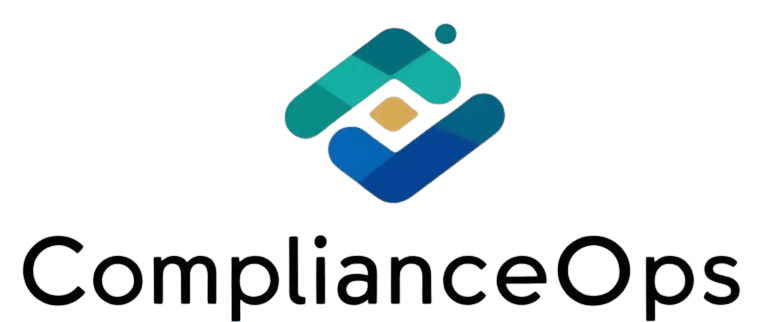Frequently Asked Questions (FAQs)
We know compliance can be complex. Here are answers to common questions from businesses like yours.
What is ComplianceOps in everyday terms?
It’s an online workspace that keeps all your compliance jobs—policies, tasks, evidence, and audits—in one organised spot. It automates the paperwork, reminds you of deadlines, and shows a live “ready score,” so you stay prepared instead of rushing at the last minute.
How quickly can we be up and running?
Most teams reach “audit-ready” in four to six weeks. Week 1 is a free gap scan, Weeks 2–3 connect your tools and pull in documents, and Weeks 4–6 close gaps and train your team. Larger programs add more playbooks, not more pain.
Is our data really safe?
Yes. Everything is encrypted in transit and at rest, stored in single-tenant cloud vaults, and every click is logged. We carry the same badges we help you earn—SOC 2 Type II, ISO 27001, GDPR.
What return on investment should we expect?
Most customers cut manual compliance work by 60-70 % in year one, which frees staff to close deals, ship features sooner, or avoid hiring extra head-count.
How does support work after launch?
You get a named Customer Success Manager, 24 × 7 chat, and quarterly health reviews. Enterprise plans add a private Slack channel and priority phone support.
What does “integration” really mean?
We wire up your ticketing, HR, code, and cloud tools to one dashboard. Controls link to evidence automatically, so policies prove themselves in real time.
Will IT still stay in control?
Yes. Your admins decide which data flows in, who can see it, and when the connection is paused or deleted. Nothing is shared without your say-so.
Can we tweak the automation later?
Absolutely. Turn any task on or off, change the schedule, or add a manual step when a human sign-off is needed.
How does ComplianceOps spot risks every day?
It checks cloud settings, vendor scores, expiring certificates, and more. If something drifts outside your chosen guard-rails, you get an alert with a plain-English fix.
Will we drown in false alarms?
No. You set the risk threshold. For example, you might only flag a cloud mis-configuration if it exposes customer data, not an internal test bucket.
Do vendors need their own accounts?
No. They answer a short questionnaire or share their report once. You see the score; they don’t need to learn a new tool.
How “real-time” is the live dashboard?
Most checks refresh every few minutes. Critical cloud events can appear in under a minute.
How long does it take to prepare an audit pack?
One click. Select the framework and date range, and the system bundles every policy, log, and proof into a shareable link your auditor can open immediately.
Who gets the most value from it?
Fast-moving companies that can’t afford surprises: tech start-ups racing for funding, fintechs juggling new regulations, healthcare firms protecting patient data, e-commerce stores handling card payments, and IT service providers living under security reviews.
Do we have to replace our current tools?
No. ComplianceOps plugs into the apps you already use—cloud drives, ticketing systems, HR and payroll, code repos, even on-prem servers. If a system has an API or a login screen, we can connect to it.
What does it cost?
Pricing is subscription-based. You pay for a bundle of users plus the number of automated “connections” to your tools. Start small; scale only when you add more checks.
Will we still need outside auditors?
Yes, auditors still sign off on frameworks like SOC 2 or ISO 27001. The difference is that they find the evidence waiting inside ComplianceOps, so they finish in days instead of weeks.
What happens when rules change?
We monitor updates to frameworks (GDPR, HIPAA, PCI-DSS, SOC 2, ISO, FedRAMP, and more) and push new controls or tasks straight into your workspace. You get a heads-up first, so nothing is a surprise.
How long does the wiring take?
Popular apps connect in minutes with an API key. Older or custom systems may need a secure agent or nightly file drop, which our team sets up for you. Most clients finish the first round in under two weeks.
What gets automated first?
The repetitive chores—collecting system logs, checking password rules, verifying staff training, and tracking policy review dates. You pick a framework (say SOC 2), click “Auto Collect,” and timers start pulling evidence daily, weekly, or monthly.
What if some evidence must stay manual?
No problem. Upload a file once—like signed board minutes—and the platform ties it to the right control and reminds you next year.
What kind of alerts will we see?
Critical issues trigger e-mail, Slack, or Teams pings. Lower-level warnings show on your dashboard so you can plan a fix before the next audit.
How do we onboard a new vendor?
Send them a secure link or upload their SOC 2 or ISO report. The platform reads the document and scores the vendor against your policy.
How often are vendors reviewed?
You choose—quarterly for high-risk suppliers, yearly for lower-risk ones. The system reminds both sides when it’s time to refresh. If a vendor fails a key control, you’ll see a red flag until the gap is closed.
Can we schedule reports for our board?
Yes. Pick the format (PDF or web link), choose weekly or monthly, and ComplianceOps emails a clean summary with charts and key stats.
